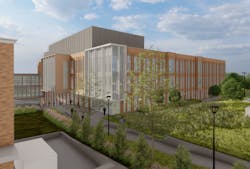University of Michigan approves Geo-exchange project to supply Carbon-free Heating and Cooling to Campus Building
The University of Michigan’s Board of Regents has approved a geo-exchange project to provide low-grade heat and cooling to supply the on-campus computer science and information building currently in pre-construction stage.
Earlier this month, regents signed off on the plan for the $20 million project adjacent to the UM’s Leinweber building. Geo-exchange, similar to geothermal systems, uses the Earth’s constant subsurface temperature as a heat-sink in the summer and low-grade heat source in the winter.
The systems do not burn fossil fuels and thus contributed to on-campus decarbonization efforts.
The geo-exchange project should be completed by the winter of 2025. The new 163,000-square-foot Leinweber Computer Science and Information Building (see rendering) on the University of Michigan’s North Campus will be the new home for the School of Information (UMSI) and expansion space for Computer Science and Engineering Division (CSE) of Michigan Engineering, bringing the two together under one roof for the first time.
Related stories
Creating New Campus Power for the future: Case Study at UConn
University of California campuses cull GHG Emissions
The Big IDEA: Creating Decarbonization and Resiliency for Energy on Campus
See our EnergyTech webinar on Schools creating Energy Sustainability, Resiliency
“Meaningful climate action is integral to our mission to serve the people of Michigan and the world,” President Mary Sue Coleman said in a university news release. “It’s on us to develop innovative approaches and build on our leading research and operations. I’m confident that the Leinweber Building geo-exchange project will give U-M the opportunity to build on this promising energy source, and to chart the way for like-minded institutions around the world.”
The Leinweber geo-exchange facility, which will be constructed on Hayward Street, will serve as an initial project as the university continues to evaluate additional geo-exchange heating and cooling opportunities on campus. U-M also is launching a utility master planning process on North Campus to investigate how to decarbonize the campus’ heating and cooling infrastructure.
Currently, U-M is sourcing approximately half of the Ann Arbor campus’ purchased energy — 200,000 million kilowatt-hours per year — from renewable energy. By 2025, the university expects to procure 100 percent of its purchased electricity from renewable sources, thereby achieving net-zero emissions from purchased power.





